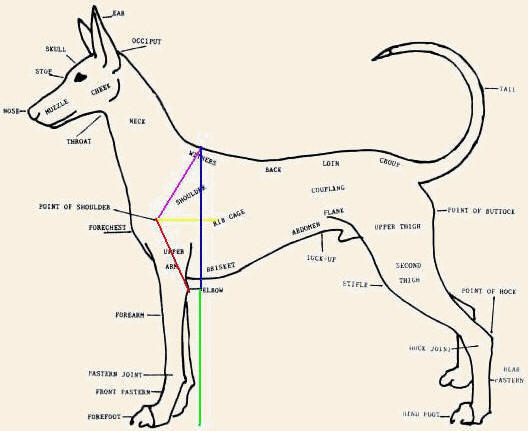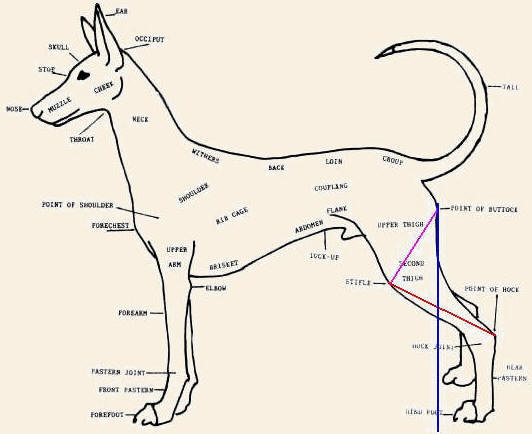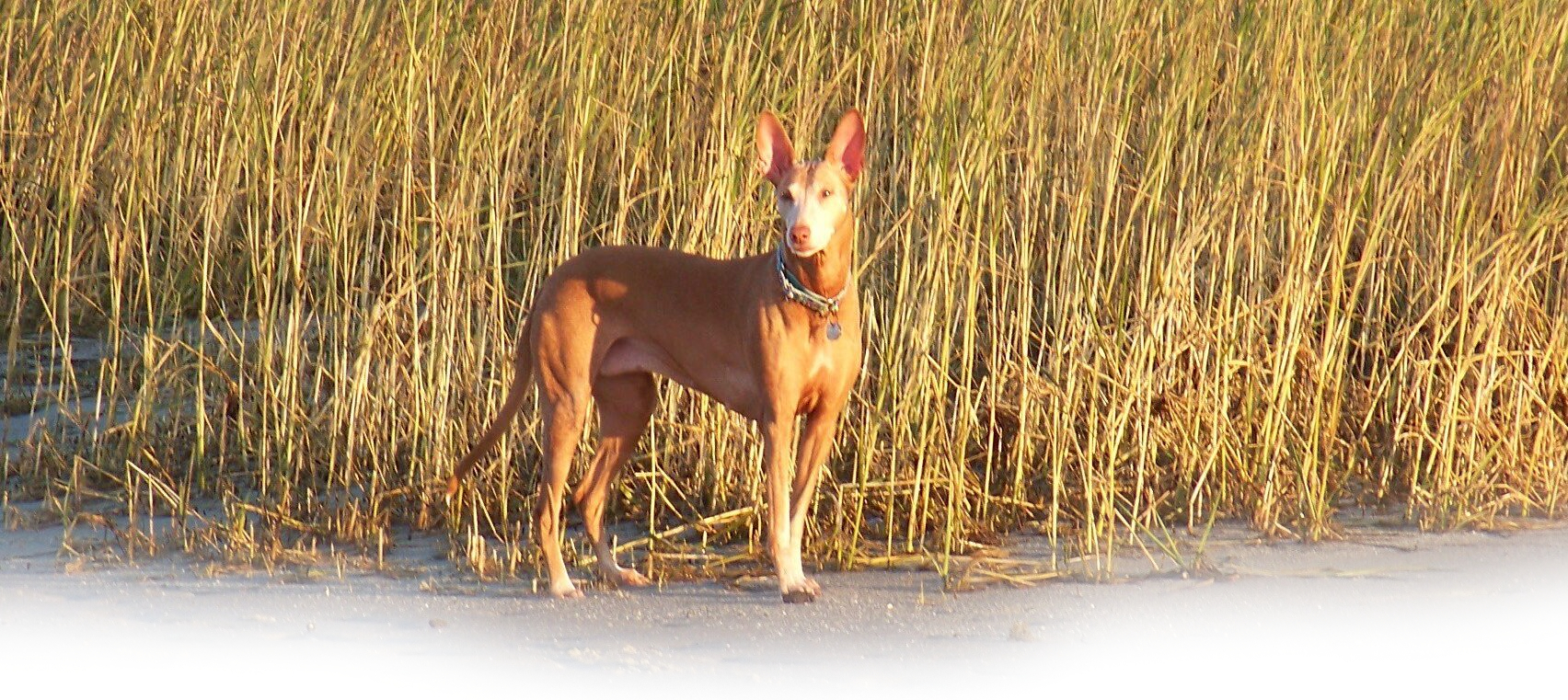The drawing below is from the PHCA illustrated standard and their version of the ‘ideal Pharaoh Hound’. In my opinion, although most parts are well portrayed, most judges would not find the topline or upper arm on this dog to be ideal.
Below are my own comments on what is described in the Pharaoh Standard and what I strive for in my breeding.
Front assembly
It is not easy to see the bones described in these drawings, you usually must use your hands to feel for them.

Shoulder and shoulder layback (pink line on the drawing)
The shoulder blade should be laid back on a 45 degree angle to the ‘center line’ (yellow).
Keep in mind that what your eye perceives when you look at a dog is what matters. Judges don’t get out a protractor and ruler. They only use their eyes and their hands.
Feel for the tip of the shoulder blade, this is called the withers, and the other end where it meets the upper arm.
You should also be able to get 3 fingers in between the tips of both shoulder blades (so that a sighthound can grab a bunny on the run and not have those shoulder blades clash together… they should not be too close.)
The layback of the shoulder in the drawing appears correct or close.
A fault sometimes seen is a ‘steep shoulder’ which is too upright.
Upper Arm (red line)
The upper arm should return on a 45 degree angle to the ‘center line’ (yellow).
This is from the point of shoulder to the elbow.
The upper arm and shoulder blade should be of equal length.
The return of upper arm in the drawing appears inadequate. The angle appears greater than 45 degrees and the upper arm looks slightly shorter than the shoulder.
A common fault in this area is an upper arm that is too upright and also too short.
The total angle between the shoulder and upper arm should be 90 degrees.
The entire front assembly (shoulder and upper arm) should also be placed ‘well back’ on the rib cage. The dog should appear to be standing ‘over their front’. Ample forechest should be visible from the side and be well filled in front. The elbow should be near the deepest part of the chest.
Also the front pasterns should be only slightly angled and not too long.
Height Ratio
The distance from the top of the withers to the elbow, should be approximately equal to the distance
from the elbow to the ground. If one is slightly longer, it should be from elbow to ground.
Rear
The rear should balance the front with a 90 degree angle.
The thigh and 2nd thigh should also be of equal length.
The hock should be short for smooth drive.


Thigh <called upper thigh on drawing> (pink line) and
Second Thigh (red)
The dog in the drawing has a 2nd thigh that is too long, causing ‘over angulation’ of the rear.
One visual test for this is draw a line from point of buttocks to the ground. It should fall directly in front of the rear toes. In this case the rear toes are behind the line.
The term over angulated is also used if the rear angle is less that 90 degrees. Over 90 degrees is ‘under angulated’ in rear.
The most common rear faults are under angulation and long hocks (called rear pastern in the drawing.)
Movement
A Pharaoh Hound should have good reach in front and drive in rear and move with each set of legs in a parallel track.
There should be minimal lift of feet (called ‘daisy clipping’ movement), which wastes no movement. There should be no lift or hackney in front, no popping of elbows, no throwing of front legs outward, or crossing over front and/or rear.
For the front and rear to work together to create sound movement they must be balanced. Which means of equal angle and power. All the parts of the front and rear assembly will affect how a dog moves.
The only part of the body that does not affect movement is probably the head!
The length of body is also important. The body must be long enough to allow the front and rear feet to come together underneath and not get in each other’s way. If they touch, a dog will compensate by ‘crabbing’ which means they move their rear off to the side and will look as if they are moving away on an angle.
The ratio of the length of the rib cage to the length of the loin is also important. If the loin is too long, the topline may be weak and sag. It should be strong and held level on the move, without sagging, bouncing or rolling.
The neck set is also important. A low neck set results in a throaty appearance with a bulging neck in front. Dogs with this neck set often want to carry their head low when they move and this in turn often widens up their front on the move.
Photo Analysis
Keep in mind the analysis of conformation from a photo is only as good as the photo. The dog must be stacked perfectly, the photo shot dead side-on and at dog height.. which never happens. Look at several photos of the same dog to confirm what you think you see.
